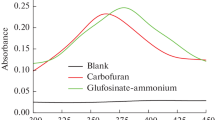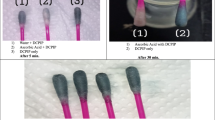Abstract
The possibility to determine herbicides in the aqueous environment by observation of inhibiting effects on the photosynthesis of isolated chloroplasts have been critically evaluated. The photosynthetical activities of freshly isolated chloroplasts from spinach (Spinacia oleracea L.) and peas (Pisum sativum L.) have been compared under well-defined conditions. The standard for the rate of photosynthesis was the oxygen evolution, which has been detected by a Clark-type electrode. The ratio between the oxygen production rate before and after a sample addition describes the chloroplast activity. In the presence of herbicides this ratio decreases. Increasing herbicide concentrations have been determined by a normalization procedure in semilogarithmic scales using a sigmoidal calibration plot.
Photosynthesis inhibiting substances, both natural and anthropogenic, can be detected collectively. That is an advantage over enzyme immunoassays which can only detect single herbicides. Clearly disadvantageous are the insufficient detection limits (e.g. 8.9 μg/l for atrazine, respectively 2.5 μg/l for terbuthylazine) and therefore the necessary preconcentration.
Similar content being viewed by others
References
G. M. Zimmermann, L. Weil, P. Herzsprung, K.-E. Quentin,Z. Wasser-Abwasser-Forsch. 1989,22, 73.
G. M. Zimmermann, L. Weil, P. Herzsprung, K.-E. Quentin,Vom Wasser 1990,74, 195.
A. Trebst, J. Kluth, K. Tieben, W. Draber, in:Pesticide Chemistry: Advances in International Research, Development and Legislation (H. Frehse, ed.), VCH Weinheim, 1991, pp. 111–120.
R. J. Youngman, E. F. Elstner, in:Pflanzentoxikologie: Der Einfluβ von Schadstoffen und Schadwirkungen auf Pflanzen (B. Hock, E. F. Elstner, eds.), Bibliographisches Institut, Mannheim, 1984, pp. 132–151.
J. A. Bassham, G. Levine, J. Forger,Plant Sci. L. 1974,2, 15.
K. J. Lendzian, H. Ziegler, N. Sankhla,Planta 1978,141, 199.
H. Metzner,Pflanzenphysiologische Versuche, Gustav Fischer, Stuttgart, 1982, pp. 3–11, 15–17.
K. J. Lendzian,Plant Physiol 1980,66, 8.
K. J. Lendzian,Planta,1978,141, 105.
P. Schöpfer,Experimentelle Pflanzenphysiologie: Einführung in die Anwendungen, Springer, Berlin Heidelberg New York Tokyo, 1989, p. 440.
R. G. Jensen, J. A. Bassham,Proc. Natl. Acad. Sci. 1966,56, 1095.
J. A. Nelder, R. Mead,Comput. J. 1965,7, 308.
D. Rodbard, in:Mathematics and Statistics of Ligand Assay: An Illustrated Guide (J. Langan, J. J. Clapp, eds.), Masson Publishing U.S.A., 1982.
M. G. Weller, L. Weil, R. Niessner,Mikrochim. Acta 1992,108, 29.
R. Carpentier, C. Loranger, J. Charternd, M. Purcell,Anal. Chim. Acta 1991,249, 55.
B. Hirschwald,Z. Wasser-Abwasser-Forsch. 1990,23, 184.
U. F. Franck, N. Hoffmann, H. Arenz, U. Schreiber,Ber. Buns. Ges. 1969,73, 871.
U. Schreiber, L. Groberman, W. Vidaver,Rev. Sci. Instrum. 1975,46, 538.
M. F. Hipkins,Biochim. Biophys. Acta 1978,502, 514.
Author information
Authors and Affiliations
Rights and permissions
About this article
Cite this article
Matuszczyk, G., Weil, L. & Niessner, R. Critical evaluation of a screening test for detection of herbicides by inhibiting photosynthesis of isolated chloroplasts. Mikrochim Acta 110, 23–30 (1993). https://doi.org/10.1007/BF01243981
Received:
Revised:
Issue Date:
DOI: https://doi.org/10.1007/BF01243981




